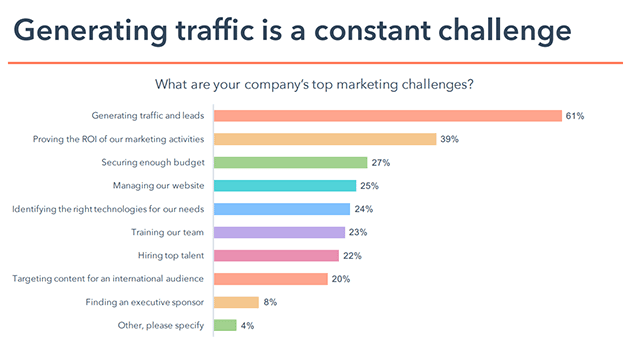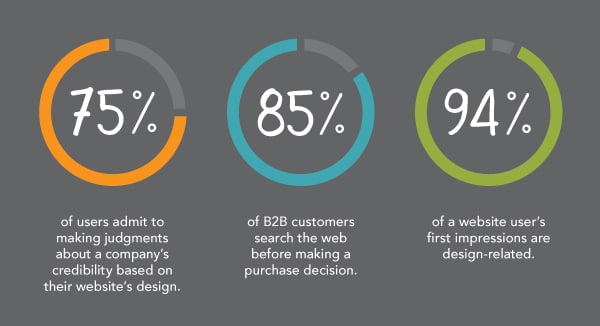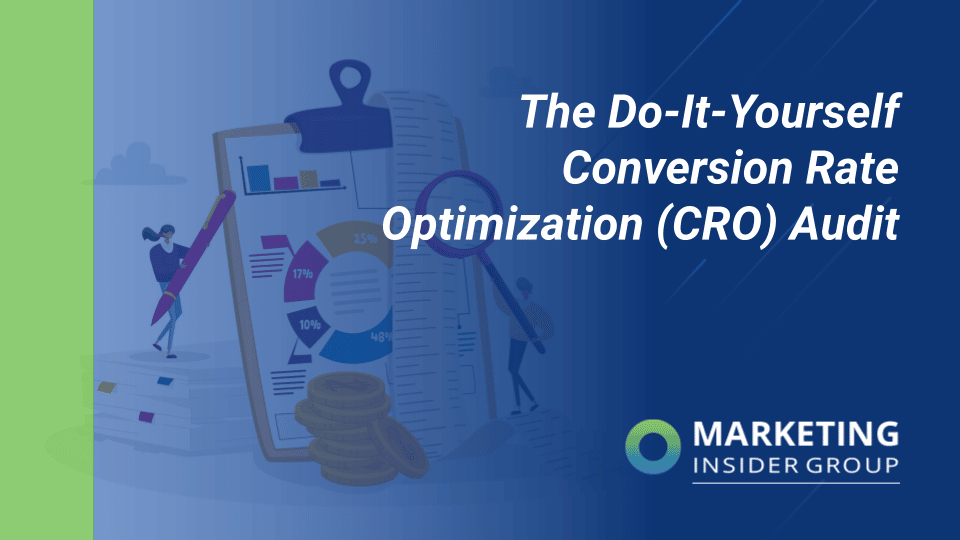
Let’s be honest, your lead generation strategy might need some work if it’s not producing ROI. The whole point of lead generation is to generate leads that close!
In modern times, B2B and B2C consumers are overwhelmed by sales, advertising and marketing teams vying for their attention. You can’t rely on one pipeline or blasting out an email to your prospect list and calling it a day.
More (quality) leads = more sales = increased revenue, which makes everyone happy. You need a long term strategy that incorporates each aspect of your business and pulls in the expertise of each department.
However, lead generation often starts with marketing.
Quick takeaways:
- Majority of B2B marketers are struggling with lead generation – you’re in the right place!
- Don’t put all of your eggs in the email campaign basket – diversify your lead generation strategy.
- Each lead generation avenue comes with its own means of tracking data and ROI.
- SEO-driven content on your website could help drive organic traffic and leads to you today!
What does lead generation look like today?
Lead generation is the process of identifying, qualifying and nurturing potential customers for a business’s products or services.
You can generate leads through a number of different ways. Some examples include:
- Content marketing
- In-person events
- Direct marketing
- Email campaigns
Each lead generation avenue should be employed with an end goal in mind. For example, if you’re planning an in-person event to target your audience 1:1, come prepared with compelling visual aids that draw them in. Bring your top sales and product reps to nurture new connections and share how your company can solve their problems.
Another key component to lead generation ROI is by investing in education for your customers, and consistent messaging across channels. Content marketing ties into each area of lead generation because it not only provides your team with a landing page of resources to reference in emails and conversations with potential customers, but also offers a way for your audience to find you organically.
Email lists and cold calls are not going to cut it for these crafty buyers of today. If you expect customers to trust you when making a high-involvement purchase such as your products or services, you need to tailor your efforts to your audience’s requirements.
By building and fostering connections with prospects at multiple touch-points, your prospects could turn leads and soon, paying customers.
Why is Lead Generation ROI Important?
You’re not alone! 61% of marketers say that lead generation is their number 1 challenge. Second at 39% is proving lead generation ROI.

Each means of lead generation will come with its own set of rules and standards. But acquiring and converting leads is clearly a major pain point in the realm of business that you can begin to solve today.
We understand, you’re responsible for the decisions you make and it all comes back to ROI. How do you measure lead generation ROI to show your boss that your efforts are paying off and contributing to the bottom line?
5 Steps to Improve Lead Generation ROI
Step 1: Set your objective with clear goals
The metrics you choose should be quantifiable and aligned to your sales goals. Think sales, leads, pipeline. Focus on the goal – not the way to get there.
Sit down with your Sales VP and ask them what they want. If they want only “Hot Leads” ask how they define that. Create a lead scoring system. Aim to deliver to the right quality and then forecast the quantity.
Focus on delivering quality over quantity.
Step 2: Create your marketing plan
Use past performance to determine what worked. It might benefit you to take inventory of all of your former means of lead generation and marketing campaigns to find trends and gaps in the data. Maybe there’s an old email campaign that could be repurposed or modernized.
Reverse-engineer previous tactics that have delivered exactly what your sales peers have asked for. This is a quantifiable science. There are plenty of statistical modeling tools that can help you determine which mix of tactics, topics, and partners will deliver a predictable result.
Another part of your plan that shouldn’t take more than a few weeks of dedication is to clean and update your website, testimonials and reviews, and social media.
Website
Your website should not only be optimized for search, but it should act as its own lead generation machine. You should be proud to showcase your work and send prospects through a seamless buying journey.
Having a well-designed, mobile-friendly, and easily navigable website is a must today.

Keep in mind, a fantastic website will cost you a sizable chunk of money, but the ROI is immeasurable.
Testimonials
Are you asking for Google reviews or testimonials? Maybe your customers are raving to you privately via email about your product or service, but you feel uncomfortable asking for a public review.
The only mistake you’re making is not asking your customers for reviews at all. Start by asking them to copy and paste what they’ve already written to you in a Google review. It’s public, and then you could even turn it into a visually pleasing asset on your website! Two birds, one stone.
Social media
Social media can amplify your presence in the industry, but don’t be a robot.
If you’re willing to invest in the proper social platforms for your business, you could attract unique leads who appreciate what you have to say.
Step 3: Negotiate with top partners
Call those vendors that have delivered targeted prospects that have converted in the past and negotiate on a pay-for-performance basis. Your partners need to share the risk of your investment and they will reap the rewards in renewed sales.
Now might be a good time to put feelers out there for other lead generation companies. Dedicate a few hours per week shopping around and see if any agency or tool jumps out at you. If that’s too daunting of a task, ask your peers at other companies if they’ve had success with a particular agency. What works for them could work for you, too!
Step 4: Identify or create valuable content and offers
This is the trickiest part. If you have content, test which pieces work best. If you need to create content – research the top trending keywords, article titles and customer pain points.
Ask your partners. Ask your current customers. Whatever you do, do not assume that product brochures, customer case studies, or articles written by your boss will resonate.
According to Content Marketing Institute, 80% of B2B marketers utilize content marketing for lead generation. And great news, it actually works. Marketers that use blogs to generate traffic are 13 times more likely to generate positive ROIs.
Is your company blog in good shape? Or is your CEO preaching to you that you need more content on your shiny products?
Through consistent SEO blog writing, your organic website traffic could double in just 12 months. And those aren’t even cold leads, rather customers looking for answers to their problems, and you’re the one with the solution!
Step 5: Optimize & analyze
Numbers don’t lie. Use internal data to identify trends and constantly optimize based on them.
Make yourself aware of economic, social and behavioral changes within your target audience so you can adjust your messaging and strategies accordingly. Only when you know where your leads are coming from will you be able to hone in on converting them.
This is where the conversation with sales and the relationship with your vendor partners pay off. If your Sales VP isn’t happy, adjust the plan, and work with your vendors to deliver what is really needed.
Once you’ve got the basics down and the leads are pouring in, consider how your team will most efficiently manage and nurture your leads.
BONUS: Check out these 20 lead generation resources.
If you follow these 5 steps, you will produce leads and revenue for your company, build a better relationship with sales, and improve your engagement with your customers. Now go out and become a demand generation rock star and come back to tell us about your success.
With content marketing, you can drive qualified traffic to your website and engage new visitors. Build your brand story and online presence for tremendous success in the new year. Establish yourself as a thought leader and build trust with customers with quality, consistent content production.
MIG is a content marketing agency and a thought leader. We’d love to help you grow your business successfully by developing superbly written, keyword-rich articles to help your company climb the SERPs as quickly as possible.
Learn about our Content Builder Services. We’ll help you create all the content you need to win customers and boost sales.
The post 5 Steps to Improve Lead Generation ROI appeared first on Marketing Insider Group.







